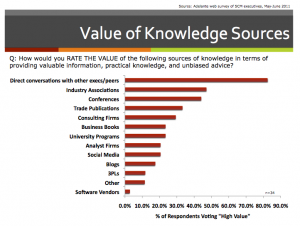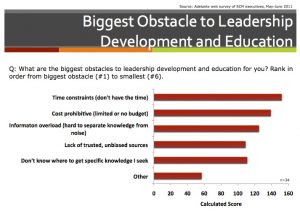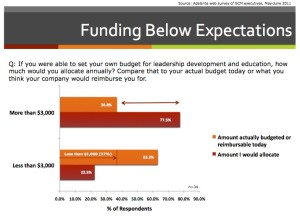Two blog posts caught my attention this week related to supply chain education and leadership development. First, Kevin O’Marah at SCM World highlighted the Top 10 Industry Associations and Top 15 Universities that executives view as “markers of supply chain talent” (based on a survey of 331 executives). As Kevin explained, the survey didn’t define “marker of talent,” relying instead on the respondent’s instinctive understanding of the idea. You can read the post for additional details and insights, but here are the top five for each category.
Industry Associations
- APICS – The Association for Operations Management (CPIM/CSCP)
- Supply Chain Council (SCOR Professional)
- Institute for Supply Management (CPSM/CSM/CPSD)
- Project Manager Professional (PMI certifications)
- Council of Supply Chain Management Professionals (SCPro Certification)
Universities
- Michigan State University
- Massachusetts Institute of Technology
- Pennsylvania State University
- Arizona State University
- Stanford University
What surprised me the most wasn’t the names on the lists or their rankings, but what was missing: A question gauging how executives view other sources of supply chain learning and knowledge. In a survey I conducted almost three years ago, supply chain executives didn’t view universities or industry associations as the most valuable knowledge source; number one on their list was “direct conversations with other executives and peers” — in other words, peer-to-peer learning and networking.
The sample size of my survey wasn’t large (34 supply chain executives), but as I continue to have conversations with executives about this topic, what I hear reinforces the findings: “Who better to give me practical knowledge and advice about a problem or opportunity I’m working on than other executives who have already been down that road.”
Granted, I’m biased when it comes to peer-to-peer learning considering the focus of my company. But I’m not alone in believing a new model of learning is required in supply chain management. In their book A New Culture of Learning, Douglas Thomas and John Seely Brown argue the following:
“The major pitfall of the 21st century’s teaching model is the belief that most of what we know will remain relatively unchanged for a long enough period of time to be worth the effort of transferring it…The old ways of learning are unable to keep up with our rapidly changing world [emphasis mine].”
I believe this is particularly true in supply chain management, where new technologies, business models, competitors, legislation, economic issues, and so on are constantly emerging, which requires companies to continuously evolve their supply chain thinking, processes, and networks. Just look at trends such as social networking and omni-channel retailing — neither of these things were likely included in supply chain textbooks or courses developed just a few years ago. Thomas and Brown position peer-to-peer learning as a more effective learning model in rapidly-changing fields like supply chain management.
Bill Taylor, cofounder of Fast Company magazine, makes a similar point in an HBR blog post published a couple of years ago titled, Are You Learning as Fast as the World is Changing?:
These days, the most powerful insights often come from the most unexpected places – the hidden genius locked inside your company, the collective genius of customers, suppliers, and other smart people who would be eager to teach you what they know if you simply asked for their insights…Nobody alone learns as quickly as everybody together.
But the big elephants in the room when it comes to learning and leadership development are time and money: many supply chain professionals don’t make the time for it, and many companies underinvest in it and are quick to cut the budget when times get tough.
For related commentary on this topic, I encourage you to read some of my past postings:
- Putting Leadership Development Back on Your Calendar
- The Most Important Attribute of a Supply Chain Leader
- What’s Missing from Your 2014 Budget?
The other post that caught my attention this week was Investing in Tomorrow’s Supply Chain Industry Leaders by Steve Raetz, Director of Supply Chain Integration at C.H. Robinson (a Talking Logistics sponsor). Steve writes that “investing in the future starts with the people who will be part of our industry tomorrow, and next year, and ten years from now. Which brings the question, how do we invest in people who don’t even work in the industry yet?” He goes on to highlight how C.H. Robinson works with various universities, programs, and students “to answer relevant industry questions and solve complex challenges we all face every day.”
For example, C.H. Robinson sponsored a case competition with the University of Minnesota, Carlson School of Management’s Supply Chain and Operations Department. This nationwide case contest was for undergraduate students and the prize for the winning team totaled $7,500. Here are some details from Steve’s post:
For those of you who don’t know what’s involved in a case competition, it’s a unique and rather fun way to learn and develop innovative solutions to some common (and some not so common) industry challenges. Similar to Mock Trial or Model U.N., teams of students receive a hypothetical situation and 24 hours in which to develop a solution for their challenge. After the time is up, students present their proposed solution to a panel of judges. This proposal is similar to a closing pitch they would experience in the “real world.” The judges are experts from companies in the industry. While the judges are provided with a rubric for choosing a winner, they can also base their selection on their own personal experiences in the industry. For the Minnesota event this past April, the team from Indiana University, Kelly School of Management took home the prize.
I believe this is a great example of how industry leaders in the private sector (manufacturers, retailers, 3PLs, technology vendors) need to work more collaboratively and creatively with universities to help prepare the next generation of supply chain and logistics leaders. In my opinion, more work needs to be done at the community college and high school levels too, but I’m also seeing progress on those fronts.
The bottom line is that we need to think beyond traditional paths to learning when it comes to supply chain management. Universities and industry associations will continue to play an important role moving forward, but so will new peer-to-peer learning models enabled by social networking technologies and communities (see A Pulse on Social Networking for Supply Chain Management). We also need more creativity and collaboration between employers and educators to make sure the next generation of supply chain professionals — not only students at “name brand” universities, but also high schoolers and community college students — are developing the right knowledge and skills to succeed when they enter the workforce, especially in areas like technology and analytics. And of course, none of this matters if supply chain professionals don’t carve time from their busy schedules to learn and teach, and if companies continue to underinvest in learning and leadership development programs.
A version of this post was also published on LinkedIn. Follow Adrian:













